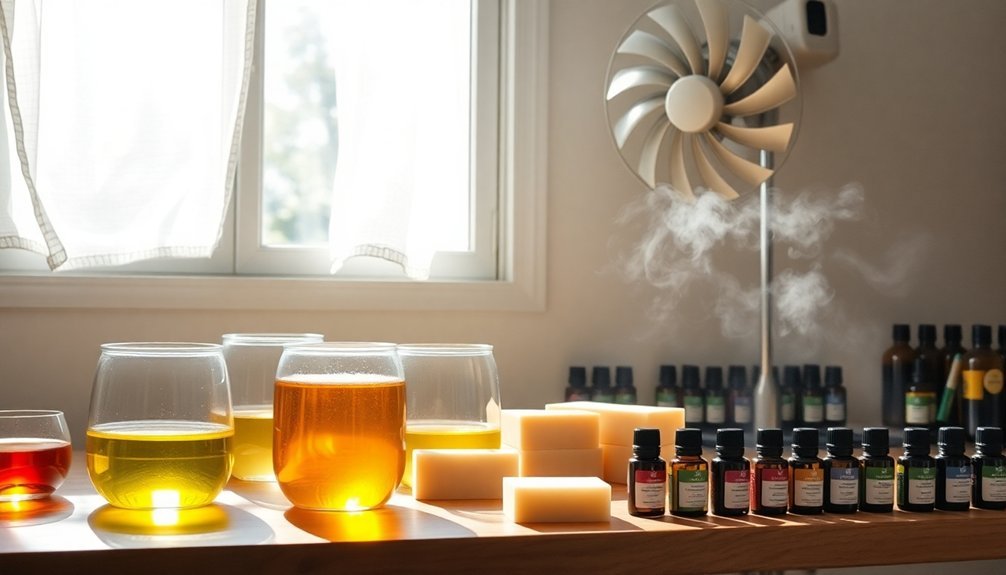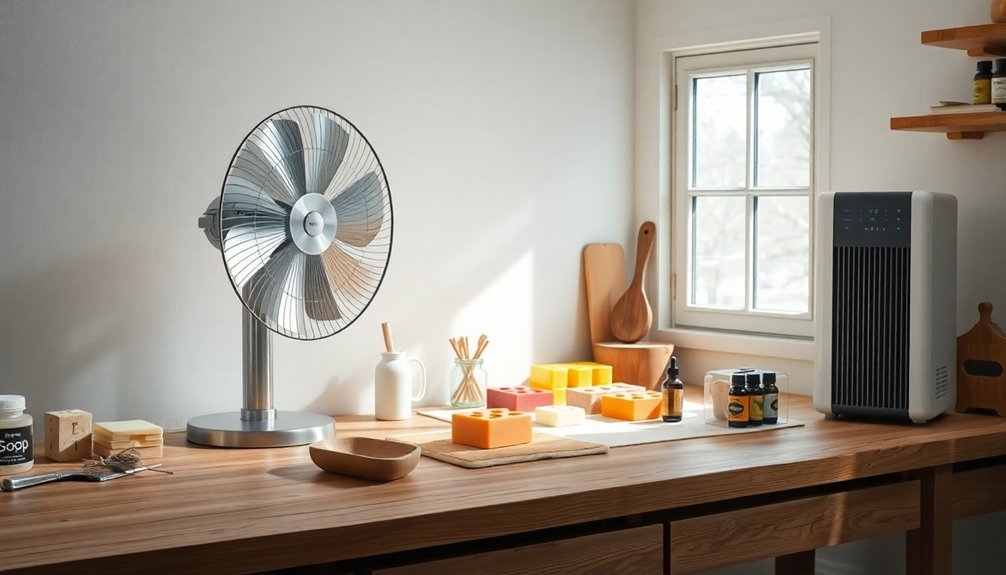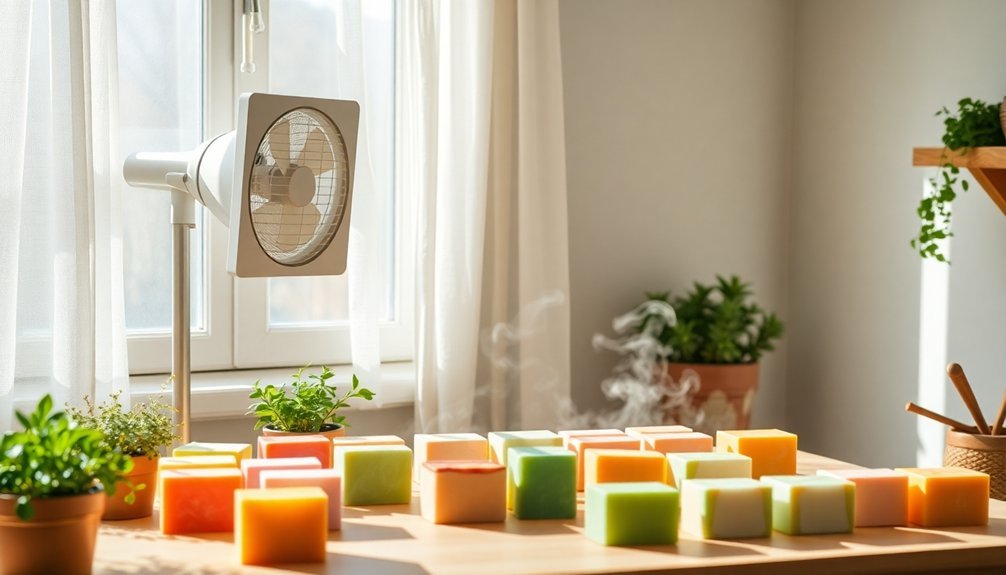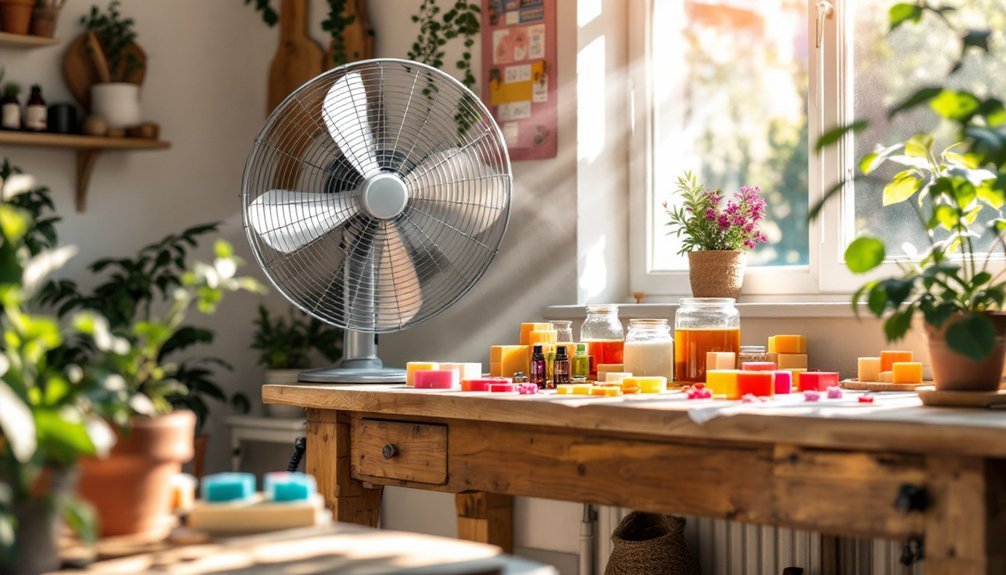Proper ventilation is vital when making soap, especially for cold process methods using lye. You'll need exhaust fans, open windows, or outdoor spaces to disperse caustic fumes that can damage your respiratory system. Hot process requires continuous ventilation during cooking, while melt-and-pour needs only basic airflow. Consider investing in respirators with VOC cartridges and positioning fans to direct fumes away from your breathing zone. Your safety and soap quality both depend on these essential airflow considerations.
Why Proper Ventilation Matters in Soap Making

When making soap at home, proper ventilation isn't just a suggestion—it's a necessity for your safety. Mixing lye with water generates potentially harmful fumes that can irritate your respiratory system and cause discomfort if inhaled.
Safety demands proper ventilation when making soap—lye fumes can harm your respiratory system if inhaled.
Without adequate airflow, these caustic vapors can accumulate in enclosed spaces, creating a hazardous environment. Proper ventilation helps disperse these fumes quickly, greatly reducing your exposure risk. The chemical reaction known as saponification process releases additional vapors that require proper air circulation.
Whether you're working in your kitchen or a dedicated soap-making area, ensuring good air circulation should be a top priority.
You'll need to take into account ventilation solutions before you begin mixing ingredients. Options range from simply opening windows for cross ventilation to using exhaust hoods, fans, or even moving your soap-making operation outdoors when weather permits.
Health Risks of Poor Ventilation During Lye Handling
The health consequences of inadequate ventilation while handling lye can be severe and far-reaching. When you work with lye in poorly ventilated spaces, you're exposed to caustic aerosols and fumes that can damage your respiratory system and skin. It's critical to remember that lye is classified as highly corrosive under Department of Transportation regulations.
| Exposure Type | Immediate Effects | Long-Term Risks | Protection |
|---|---|---|---|
| Inhalation | Burning sensation, coughing | Chronic respiratory problems | Respirator, exhaust fan |
| Skin Contact | Redness, pain, burns | Dermatitis | Chemical-resistant gloves |
| Eye Contact | Severe burns, blurred vision | Possible vision damage | Safety goggles |
| Ingestion | Shock, collapse | Internal damage | Proper storage, labeling |
Children face heightened risks due to their developing immune systems and higher respiratory rates. Remember that lye exposure effects can be delayed, making immediate safety measures essential even when symptoms aren't immediately apparent.
Essential Ventilation Equipment for Home Soap Makers

Proper ventilation equipment stands as your first line of defense against the potentially harmful effects of lye fumes and chemical vapors during soap making.
Your safety arsenal should include respirators with replaceable cartridges to filter VOCs and particulates while working with lye.
Install powerful exhaust fans or portable fume extractors to circulate and remove harmful vapors from your workspace.
Consider using air monitoring devices to measure air quality and detect dangerous particles.
Always store your materials in heat-resistant containers like glass or stainless steel to reduce fume emission risks.
Don't underestimate the power of natural ventilation—open windows can greatly enhance airflow.
For maximum safety, consider mixing lye solutions outdoors where ventilation is unlimited, especially if your indoor ventilation system is minimal.
Full face shield respirators provide comprehensive protection for both your respiratory system and face, preventing dual exposure risks during the soap making process.
Creating an Optimal Airflow System in Your Workspace
You'll need to thoughtfully arrange your soap making workspace with ventilation as a priority, positioning tables near windows and creating clear pathways for air movement.
Consider how your room's natural architecture can support cross-ventilation by opening windows on opposite sides to create a continuous airflow that efficiently removes caustic fumes.
Your strategic furniture placement should never obstruct these air pathways, as proper cross-ventilation will greatly reduce your exposure to harmful lye vapors during the soap making process. This ventilation system is essential for ensuring safety is paramount when handling potentially dangerous chemicals during your soap crafting sessions.
Room Layout Considerations
When designing your soap making workspace, strategic room layout becomes critical for maintaining both safety and product quality. Allocate at least 5 feet by 3 feet for your main work area where you'll mix and pour soap.
Position shelving and storage units to maximize efficiency while keeping ingredients organized and accessible. Arrange your space with ventilation as a priority—place work tables near windows or exhaust fans to direct fumes away from your breathing zone. Installing a robust ventilation system will effectively remove harmful fumes associated with soap making processes and significantly improve overall air quality.
Consider installing a sink nearby to facilitate quick cleanup and reduce spill hazards. Choose durable flooring like polished concrete that withstands occasional spills and simplifies cleaning.
For home setups, guarantee you can securely close off the area from children and pets. Proper lighting above your workspace will help you accurately measure ingredients and monitor soap appearance.
Cross-Ventilation Strategies
Establishing effective cross-ventilation serves as the foundation for a safe soap making environment, particularly when working with lye and essential oils that release potentially harmful fumes.
You'll need at least two openings on opposite walls—windows or a combination of windows and doors—to create proper airflow.
Position your workspace to take advantage of prevailing winds, ensuring air moves through rather than around your soap making area.
Shorter room depths allow for more efficient air exchange, which helps control humidity levels critical for proper soap curing. This natural ventilation system also removes strong odors while reducing your reliance on mechanical cooling systems.
During different seasons, you'll need to adjust your ventilation strategy to maintain ideal temperature and humidity levels, maximizing energy efficiency while creating the perfect environment for soap production. Small fans can be employed to provide consistent airflow 24/7 when natural ventilation is insufficient to maintain optimal curing conditions.
Natural vs. Mechanical Ventilation Solutions

Selecting the right ventilation system for your soap making workshop requires careful consideration of both natural and mechanical options. Each approach offers distinct advantages for managing lye fumes and chemical vapors.
Natural ventilation leverages wind and temperature differences to circulate air through windows and vents. It's cost-effective, requires minimal maintenance, and connects you to the outdoor environment. However, its performance varies with weather conditions.
Natural airflow provides an economical ventilation solution, though its effectiveness depends on the day's weather patterns.
Mechanical systems provide reliable, consistent airflow regardless of external conditions. You'll gain precise control over air quality and can integrate advanced filtration systems—ideal for year-round soap making. When working with lye granules, proper ventilation is essential as they release potentially harmful fumes when mixed with water. The drawback is higher initial and operational costs.
For best results in your soap making space, consider a combined approach: use natural ventilation when conditions permit and rely on mechanical systems during adverse weather or when working with potent chemicals.
Ventilation Considerations for Different Soap Making Methods
Different soap making methods present unique ventilation challenges for crafters.
Cold process soap requires the most stringent ventilation, as mixing lye with water releases caustic fumes. Always perform this step outdoors or near windows with exhaust fans running.
Hot process soap also demands continuous ventilation during cooking, especially when using crock pots or ovens. The prolonged heating increases fume production, though containment somewhat reduces exposure. For optimal safety, always wear proper safety gear including goggles, gloves, and an apron when working with hot process methods.
In contrast, melt and pour soap making emits minimal fumes, requiring only basic ventilation like an open window, particularly when adding fragrances.
Rebatching follows similarly, with ventilation needs closer to melt and pour than cold process methods.
For all techniques, maintain a clean workspace to prevent odor buildup and chemical residue accumulation that could affect air quality.
Maintaining Air Quality During the Curing Process

Proper air quality during the soap curing process directly impacts the final product's quality, longevity, and safety. You'll need good ventilation to allow water evaporation and complete saponification while preventing moisture accumulation. Similar to the structured data found in evaluation projects, proper ventilation metrics can help optimize your soap-making outcomes.
| Equipment | Purpose | Best For |
|---|---|---|
| Fans | Enhance circulation | Speeding up curing |
| Air Purifiers | Remove VOCs | Indoor settings |
| Dehumidifiers | Control moisture | Humid environments |
| Mesh Covers | Protect from dust | All curing soap |
| Stainless Steel Racks | Maximize airflow | Professional setups |
Place your soap in an area with temperatures between 60°F-80°F and low humidity. Consider using mesh screens that block dust while allowing airflow. During high humidity seasons, you'll need to make adjustments to prevent moisture buildup on your bars during the essential curing period.
Frequently Asked Questions
Can I Use Bathroom Ventilation for Soap Making?
Bathroom ventilation isn't sufficient for soap making. It's designed for moisture, not caustic fumes from lye. You'll need stronger ventilation like a dedicated exhaust system or fume hood for your safety.
How Long Should Ventilation Run After Mixing Lye?
You should run ventilation for at least 30 minutes after mixing lye to fully clear the air of caustic fumes. Don't stop too early, as lingering fumes can cause respiratory issues.
Do Fragrance Oils Require Different Ventilation Than Essential Oils?
No, both fragrance and essential oils require similar ventilation. You'll need good airflow regardless of which you use, though fragrance oils may have stronger, longer-lasting scents that benefit from consistent air circulation.
Can Ventilation Affect Trace Time or Saponification?
No, ventilation doesn't directly affect your trace time or saponification process. These are primarily influenced by your recipe, temperature, and mixing speed rather than airflow in your workspace.
Are Portable Air Purifiers Sufficient for Small-Batch Soap Making?
Portable air purifiers aren't sufficient for soap making alone. You'll still need proper ventilation to remove lye fumes effectively. They can supplement your ventilation system but shouldn't be your only solution for small-batch production.
In Summary
Don't underestimate proper ventilation in your soap making journey. You'll protect your respiratory health by managing lye fumes and essential oil vapors effectively. Whether you've chosen a window fan, exhaust system, or dedicated ventilation hood, maintaining good airflow isn't optional—it's essential. Your investment in ventilation equipment pays dividends in both safety and comfort, allowing you to enjoy your creative craft without compromising your wellbeing.





Leave a Reply